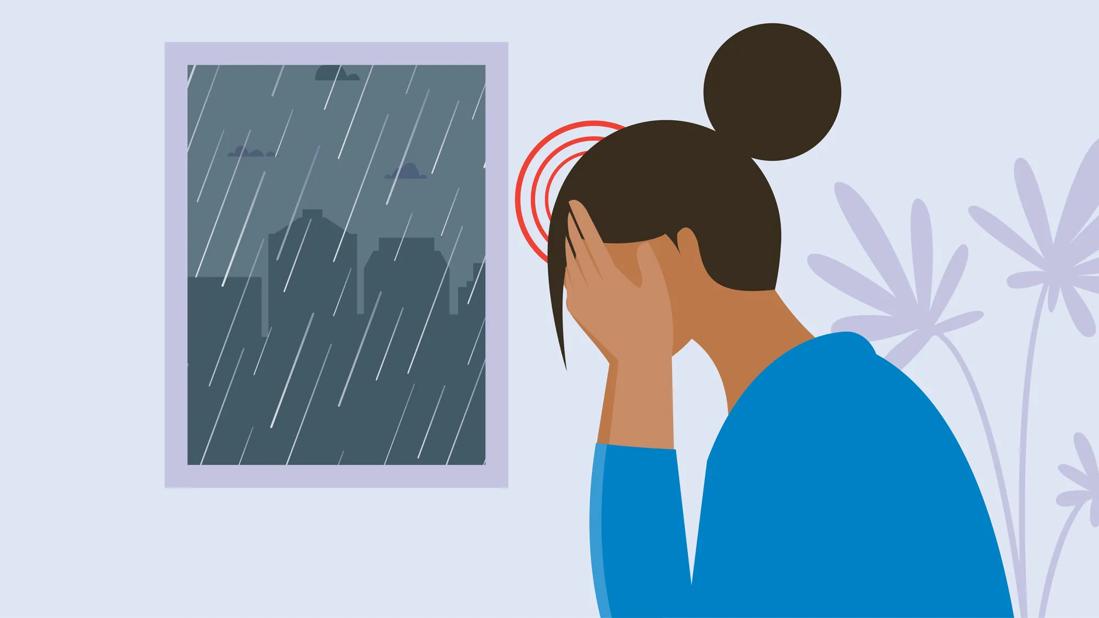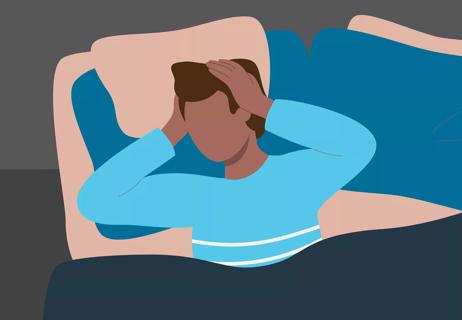The effect is very real for some people

Does the weather report often have you worried you’ll see a migraine in your forecast? Whether it’s an approaching thunderstorm or even a bright sunny day — either one can leave you with a pounding headache.
Advertisement
Cleveland Clinic is a non-profit academic medical center. Advertising on our site helps support our mission. We do not endorse non-Cleveland Clinic products or services. Policy
Headache and facial pain specialist Emad Estemalik, MD, talks about how weather can cause a barometric pressure headache or migraine and provides tips on how to keep them at bay.
People often tend to lump headaches and migraines into the same bucket.
“Many think migraines are just really bad headaches, which is not altogether true,” Dr. Estemalik says. “Headaches and migraines can have different causes.”
Headaches of any level of pain can be symptoms of a migraine attack, but a migraine is actually a neurological disease or brain imbalance that causes a lot of other symptoms in addition to headaches.
These include sensitivity to light, nausea and vomiting, stomach upset, abdominal pain, loss of appetite, dizziness, blurred vision, numbness, tingling or weakness in rare cases.
Migraine episodes result from different signals interacting with your brain, blood vessels and surrounding nerves, which cause any of the symptoms above. During a migraine headache in particular, specific nerves of your blood vessels are activated and send pain signals to your brain.
Dr. Estemalik says that using the term “barometric pressure headache” might be misleading. A lot of people who have allergies just assume they have barometric pressure headaches or sinus headaches.
Advertisement
“A lot of patients who have had sinus issues all their lives actually have migraines,” he continues. “Once we dig deep into their history and ask the right questions, the interpretation is that they have migraines and have been misdiagnosed with sinus headaches.”
While you can get a migraine from other triggers, barometric pressure can also aggravate your symptoms.
In addition to typical migraine symptoms like nausea, vomiting and light and sound sensitivity, those who have a migraine triggered by barometric pressure may experience the following:
“Those who get migraines with aura will have visual and sensory changes,” says Dr. Estemalik. “All these symptoms you wouldn’t typically see in people who just have sinus-related issues or allergy symptoms.”
Research shows that changes in weather patterns are tied to changes in barometric pressure and temperature, and in turn, this can be associated with the onset of mild to severe headaches.
“For some people, it’s a fall in barometric pressure, for others, it could be a quick rise in temperature,” says Dr. Estemalik. “Either way, when these pressure changes occur, most commonly during a storm, a headache can be triggered.”
For what we consider to be the effect of weather on migraines, we’re most likely talking about how weather can contribute to the headache part of a migraine episode.
During a storm, cold and warm air mix to create variations in barometric (or air) pressure. This also is how wind, rain and thunderstorms are created. Barometric pressure is also known as the atmospheric pressure being applied against a given area — and in this case, that “area” is you.
Because your nasal and sinus cavities are air channels, any change in that pressure, especially a fall in barometric pressure, affects those areas. This forces fluid into tissues and can cause a disruption in fluid balance.
Some researchers also think the barometric change may affect the pressure on your brain and how the way your brain blocks or doesn’t block pain.
“Weather is certainly not the only reason we get headaches. Stress, specific over-the-counter medicines like analgesics or pain killers, hormonal triggers and certain disorders related to sleep for example may also be causes,” Dr. Estemalik explains. “And while you can’t control the weather, you can take steps to minimize your risk, severity and treatment of a headache or migraine attack by following some best practices.”
Advertisement
Advertisement
Curious if there are any natural remedies you can try? Dr. Estemalik says there are three over-the-counter supplements that he recommends:
Though you can’t control when it rains or when temperatures spike or fall, you can take steps to manage and even prevent your migraines.
“If you seem prone to migraine headaches or if they are disrupting your life, be sure to talk to your doctor,” Dr. Estemalik says. “They will work with you to identify triggers as well as the best treatments.”
Advertisement
Learn more about our editorial process.
Advertisement

Exercising, hydrating and other natural remedies can help a headache without the meds

Certain components found in wine like tannins and histamines may be the culprit

TMJ pain can cause headaches, but chiropractic treatments, lifestyle adjustments and medication can help ease discomfort

Dehydration, spinal fluid leaks and other conditions can cause positional headaches when you stand up

It’s all about the amount — try to stick to 100 to 150 milligrams a day to reduce and prevent a pounding, throbbing head

Many factors, like dehydration, a cold or even your medication, can result in these common symptoms

Behind your eye, on one side of your face or as a band around your head — headaches are no fun

Yes, especially if you get migraines — but medicine can help

The ‘sunshine vitamin’ is found naturally in some fish and is added to other foods

Autism and ADHD often go hand in hand, giving rise to the term AuDHD

The Yuzpe regimen is less effective than other forms of emergency contraceptives, and it’s associated with more side effects